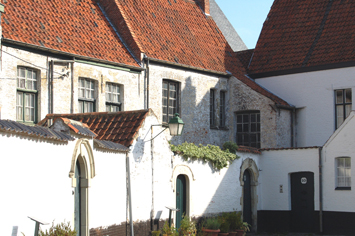Kortrijk’s Beguinage: Towards the interpretation of a UNESCO World Heritage Site
Kortrijk’s Beguinage (beguine convent) was added to UNESCO’s World Heritage List on 2 December 1998, along with 12 other, representative, Flemish beguinages. The inscription gave the Flemish beguinages international recognition as world heritage sites because of their 'outstanding universal value'. This worldwide recognition supposes that efforts be made to make these sites more easily accessible for the general public. To do so, the Ename Center works closely with the owner of the beguinage in Kortrijk, which is the local Centre for Social Welfare (OCMW).

The beguinages are a typical phenomenon in Flanders. Though they are recognised by the Catholic Church, they should not be considered as convents stricktly speaking. The women that lived in these enclaves remained independent. The origin of the beguinages goes back to the 13th century. In many cities in Flanders, they were a set part of the urban landscape, and their history was sometimes far from being uneventful. The beguinages in Flanders had their last great hey day in the 17th and 18th centuries. The appearance and architectural style of many beguinages as we know them today date back to that period. The world community recognised the unique and universal heritage value of the Flemish beguinages by adding a number of them, amongst which the beguinage of Kortrijk, to the UNESCO World Heritage List in 1998.
 This recognition as world heritage does not only bring with it the concern of conservation. It also involves a need for interpretation and accessibility. This is a delicate exercise, because an increased interest and higher number of visitors can drastically affect the nature of a site. This is especially true for beguinages, which form a peaceful enclave within a city. UNESCO is all too aware of this problem. Besides exploiting assets for regional development brought about by world heritage recognition, efforts should also be made, they argue, to establish a ‘sustainable management scheme’ for tourism. Both aspects will need to be reckoned with when making the beguinage of Kortrijk more accessible to the public.
This recognition as world heritage does not only bring with it the concern of conservation. It also involves a need for interpretation and accessibility. This is a delicate exercise, because an increased interest and higher number of visitors can drastically affect the nature of a site. This is especially true for beguinages, which form a peaceful enclave within a city. UNESCO is all too aware of this problem. Besides exploiting assets for regional development brought about by world heritage recognition, efforts should also be made, they argue, to establish a ‘sustainable management scheme’ for tourism. Both aspects will need to be reckoned with when making the beguinage of Kortrijk more accessible to the public.
In spite of the unique and typical nature of the Flemish beguinages, and even though they have been on UNESCO’s World Heritage List for more than 10 years now, a good accessibility and interpretation plan is unfortunately still lacking. Kortrijk intends to change that.
Back to newsletter
